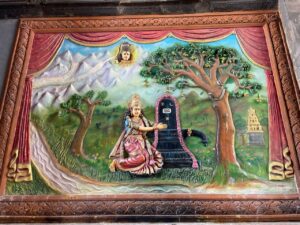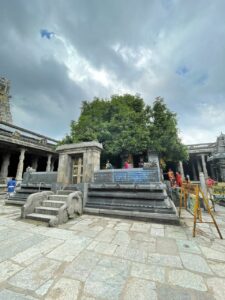Soaring at a height of 192 feet and spread over 25 acres of land, this is the largest temple dedicated to Lord Shiva in Kanchipuram.

This temple is referred to as one of the Pancha Bootha Sthalams signifying the five elements of wind, water, fire, earth and space. (Rama Ramanan/South First)
Exquisite architecture, legendary tales, and divine splendour are the pillars of Kanchipuram’s popular Sri Ekambareswarar Temple. Soaring at a height of 192 feet and spread over 25 acres of land, this is the largest temple dedicated to Lord Shiva in this temple town. It is referred to as one of the Pancha Bootha Sthalams signifying the five elements of wind, water, fire, earth and space.
Here, Siva is worshipped in the form of Earth Linga (made out of river sand). The 11-storeyed gopuram, which is the tallest of its kind in India, is adorned with intricately carved sculptures. Four magnificent gateway towers welcome visitors to the complex. The temple also houses the thousand-pillared hall, which was built during the Vijayanagar period.
It is believed that this temple was constructed around 600 CE. The temple also finds a mention in Sangam literature. According to historical evidence, during the 9th century, the Chola dynasty built the present structure of the temple. It was later expanded by the Vijayanagar kings.
Once, Lord Siva was deeply engaged in the task of creation, protection and destruction of the universe. Parvathi, His consort, in a jocular mood, closed Siva’s eyes. The obstruction to the law of nature was created by the act of Parvathi. It became a serious matter and Siva was angry with Parvathi. He cursed her to go to Earth and expiate her misdeed. Parvathi descended on Earth and arrived in Kanchipuram, on the banks of the Kamba river. She made a Sivalinga out of the river sand under a single mango tree and did penance.

Parvathi descended on Earth and arrived in Kanchipuram, on the banks of the Kamba river. where she did penance under a single mango tree. (Rama Ramanan/South First)
But forgiveness didn’t come easily. Before accepting her back, Siva created obstacles and hindrances in the way of Parvathi’s penance to examine her sincerity. At the request of Parvathi, Lord Vishnu helped her to overcome all difficulties created by Siva.
Finally, Siva created a deluge by pouring the Ganges water from His matted hair to wash out the Earth Linga worshipped by Parvathi. She elapsed the Linga with all veneration and embraced it with her hands to her breasts. Parvathi attempted it all so that the Linga was not washed away by the Ganges.
Siva was pleased and took her back as His consort. It is said that the place where Siva offered His forgiveness is where the temple has been constructed.
Another legend goes that once, Siva and Parvathi fell out in a game of dice. Siva cursed Parvathi to transform into an ugly body. Following this, Parvathi came to Kanchi. Under a single mango tree on the banks of the Kamba river, she performed penance on Siva, with the help of Lord Siva.
Finally, with the grace of Siva, Parvathi regained her beauty with dazzling eyes (Kamakshi). The name Kamakshi has been accorded to this Goddess of the temple owing to her dazzling eyes. Since Siva and Parvathi reunited under a single mango tree, the name Ekambaranatha (Eka- one, amra-mango, and natha-Lord) was given to Lord Siva. In due course, people pronounced this as Ekambareshwara.

The 3,500-year-old mango tree where the four branches represent the four Vedas. (Rama Ramanan/South First)
In the month of Phalguna (March-April), on the 10th day of Uttiram, Siva and Parvathi’s marriage is celebrated with great pomp and splendour.
The four branches of this temple represent the four Vedas. Each branch yields mango fruit with a different taste and the leaves too have a unique form. It is also believed that if a childless woman takes the fruit of the tree, she is blessed with children.
The Linga in the prakaram of this tree comprises 108 Lingas. The inner precinct of the temple is embellished with an array of Shiva lingams, one of which is a Sahasra Lingam with 1,008 Siva lingams sculpted on it. The idols of 63 Nayanmars are also present here. There are two tanks in the temple — Kampa Nadi and Sivaganga.
There is a Vishnu shrine in this Siva temple in the name of Nilathuna Perumal. It is revered as one of the 108 Divya Desams. Those suffering from skin and stomach diseases and excessive heat in the body pray to the Perumal here.’
By air: Chennai is the nearest airport at a distance of 60 km.
By train: The Kanchipuram Railway station is at walking distance from the temple.
By road: Frequent buses are available from Chennai. The temple is 2 km from the Kanchi bus stand.
The temple is open from 6 am- 11 am, 5 pm- 8 pm.
October to February is the best time to visit Kancheepuram.
‘Southern Splendors’ is a heritage travel series that serves as your go-to guide for discovering the vibrant religious, historical, and cultural landmarks that dot the scenic landscapes of South India.

Apr 28, 2024

Apr 26, 2024

Apr 25, 2024

Apr 24, 2024

Apr 19, 2024

Apr 19, 2024